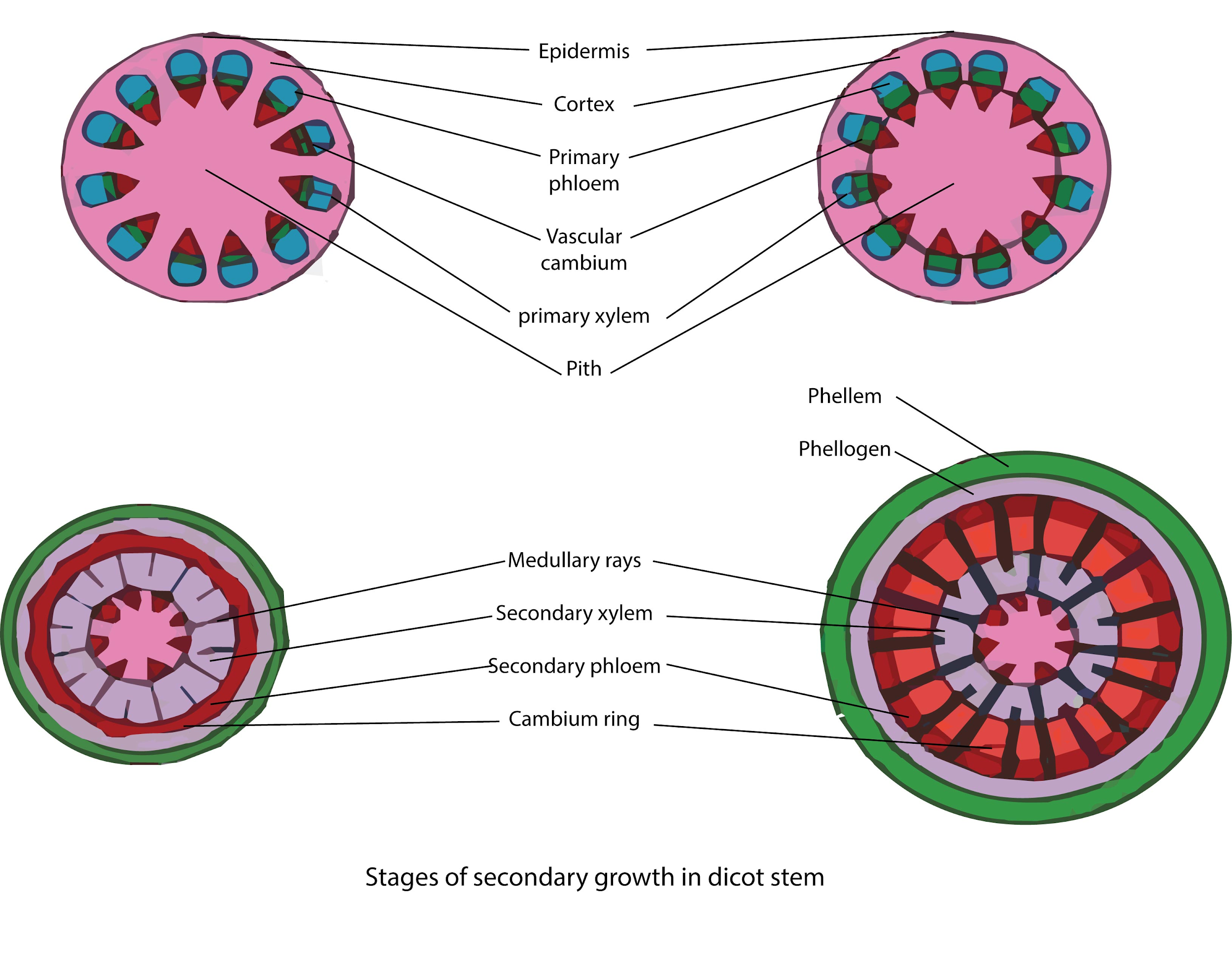
Explain the process of secondary growth in the stems of woody angiosperms with the help of schematic diagrams. What is its significance?
Answer
570.6k+ views
Hint: Secondary growth is the increase in width or girth of the stems of woody angiosperms. This process takes place due to the production of specific components in dicot stems. It is an important process in the woody angiosperms.
Complete answer:
The increase in girth or width of the stems of woody angiosperms is called secondary growth. The tissues involved in the secondary growth are the two secondary lateral meristems which are the vascular cambium and the cork cambium.
In woody dicots, a strip of cambium is present between the primary xylem and the primary phloem that is called the interfascicular cambium. The interfascicular cambium is formed from the cells belonging to the medullary rays adjoining to the interfascicular cambium. The end result is the formation of a continuous cambium ring.
The cambium divides and differentiates, forming new cells toward either side.
The cells that are present towards the outer side differentiate to form the secondary phloem, while the cells which cut off towards the pith give rise to the secondary xylem.
The cambium is more active on the inner side and as a result, the amount of secondary xylem produced is more than the secondary phloem and it crushes the pith to grow inwards forming a compact mass.
The secondary growth in woody angiosperms is important as it increases the girth of plants, that increases the amount of water and nutrients in order to support the growing number of leaves, and it also provides additional support to the plants.
Note:
Secondary growth is present only in dicotyledonous angiosperms. It is not seen in monocots and is absent in all the gymnosperms. This is due to the absence of interfascicular cambium or the cork cambium and vascular cambium in these plants.

Complete answer:
The increase in girth or width of the stems of woody angiosperms is called secondary growth. The tissues involved in the secondary growth are the two secondary lateral meristems which are the vascular cambium and the cork cambium.
In woody dicots, a strip of cambium is present between the primary xylem and the primary phloem that is called the interfascicular cambium. The interfascicular cambium is formed from the cells belonging to the medullary rays adjoining to the interfascicular cambium. The end result is the formation of a continuous cambium ring.
The cambium divides and differentiates, forming new cells toward either side.
The cells that are present towards the outer side differentiate to form the secondary phloem, while the cells which cut off towards the pith give rise to the secondary xylem.
The cambium is more active on the inner side and as a result, the amount of secondary xylem produced is more than the secondary phloem and it crushes the pith to grow inwards forming a compact mass.
The secondary growth in woody angiosperms is important as it increases the girth of plants, that increases the amount of water and nutrients in order to support the growing number of leaves, and it also provides additional support to the plants.
Note:
Secondary growth is present only in dicotyledonous angiosperms. It is not seen in monocots and is absent in all the gymnosperms. This is due to the absence of interfascicular cambium or the cork cambium and vascular cambium in these plants.

Recently Updated Pages
Master Class 11 Social Science: Engaging Questions & Answers for Success

Master Class 11 Physics: Engaging Questions & Answers for Success

Master Class 11 Maths: Engaging Questions & Answers for Success

Master Class 11 Economics: Engaging Questions & Answers for Success

Master Class 11 Computer Science: Engaging Questions & Answers for Success

Master Class 11 Chemistry: Engaging Questions & Answers for Success

Trending doubts
What is meant by exothermic and endothermic reactions class 11 chemistry CBSE

10 examples of friction in our daily life

One Metric ton is equal to kg A 10000 B 1000 C 100 class 11 physics CBSE

1 Quintal is equal to a 110 kg b 10 kg c 100kg d 1000 class 11 physics CBSE

Difference Between Prokaryotic Cells and Eukaryotic Cells

Discuss the various forms of bacteria class 11 biology CBSE




